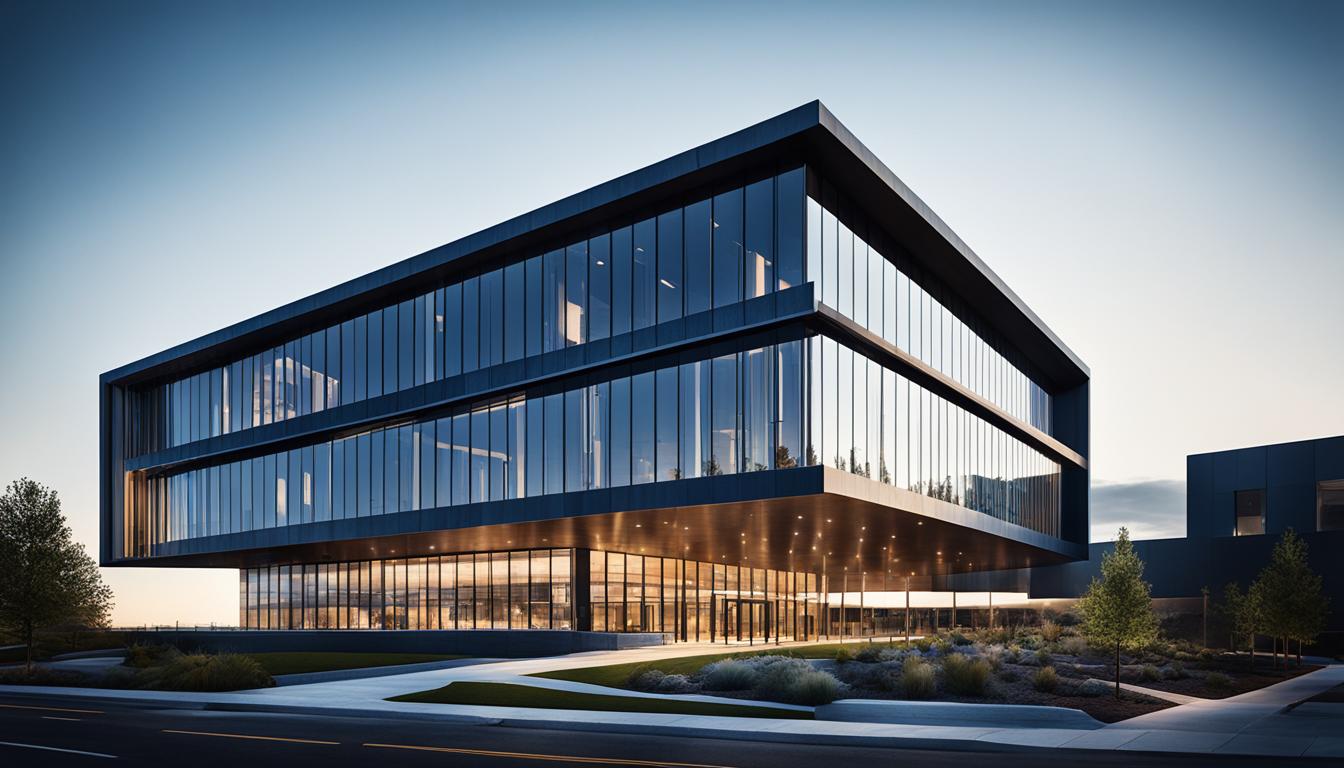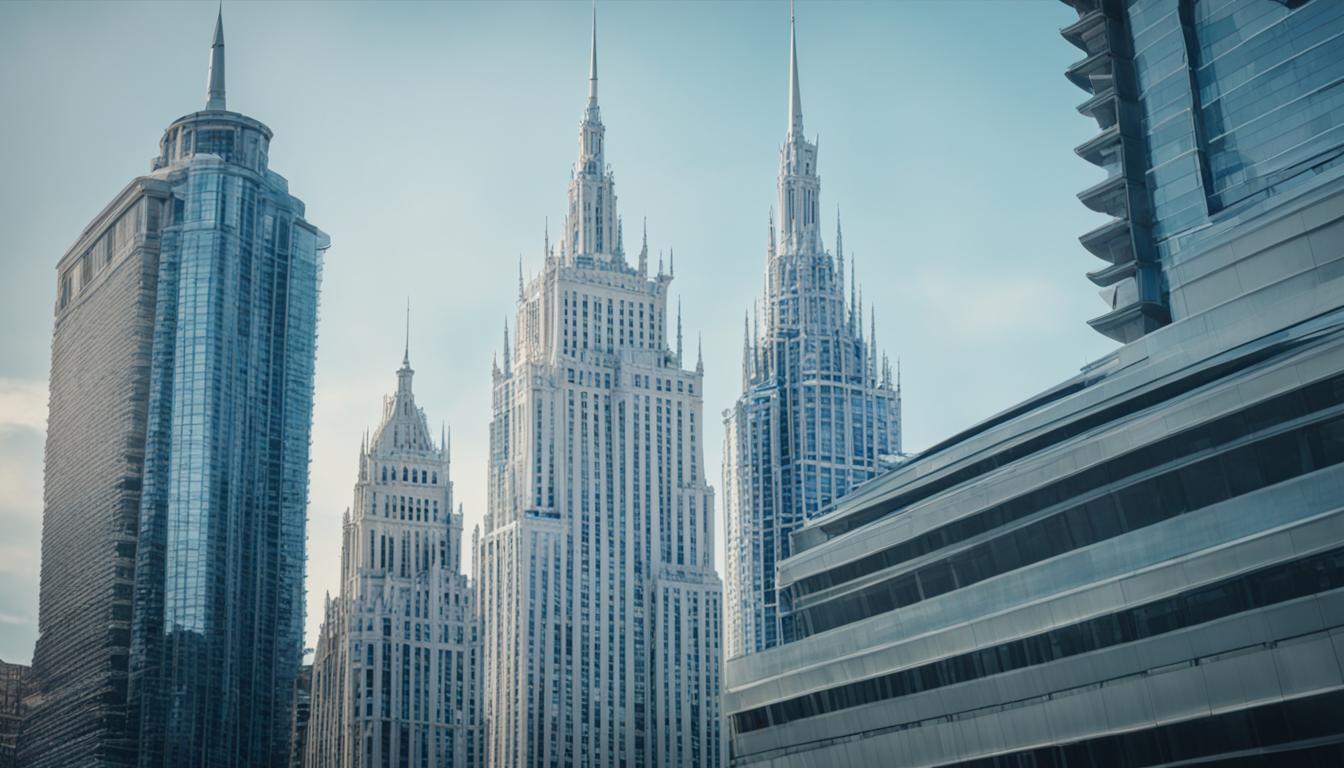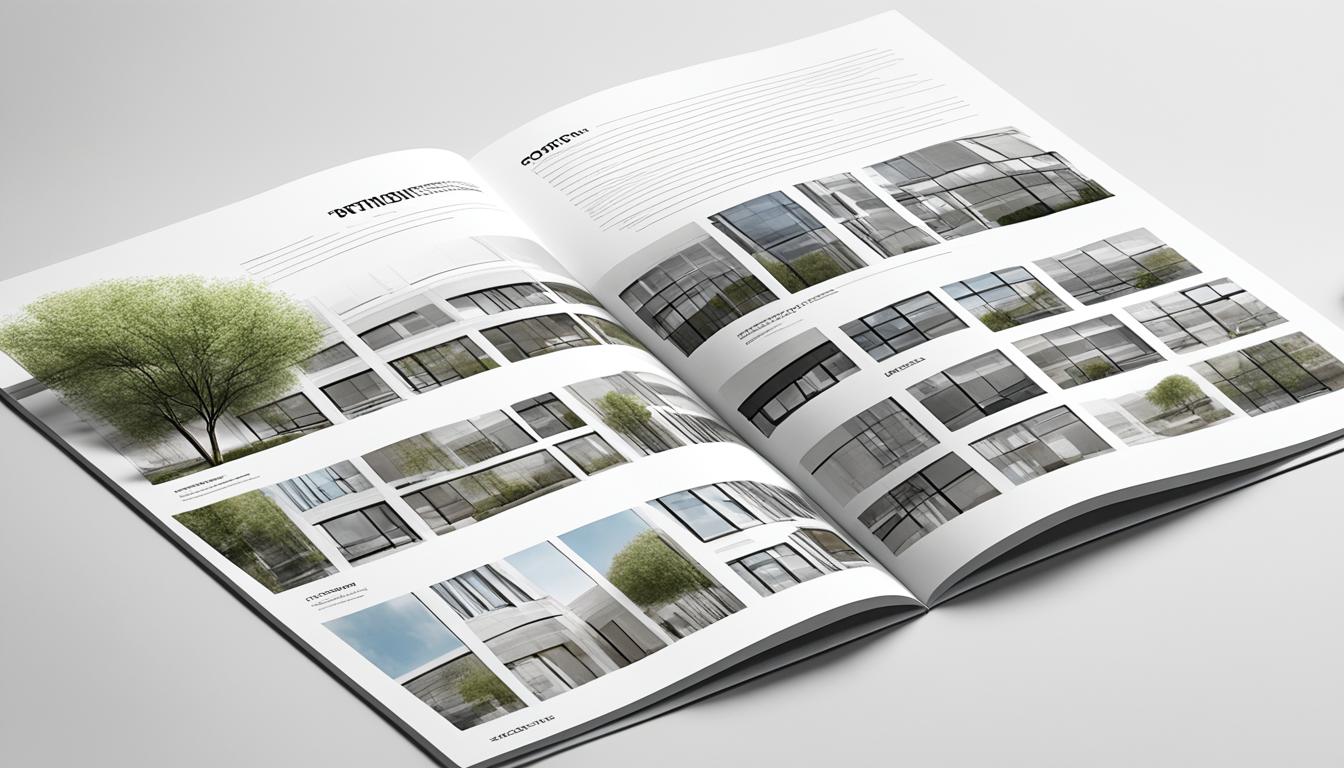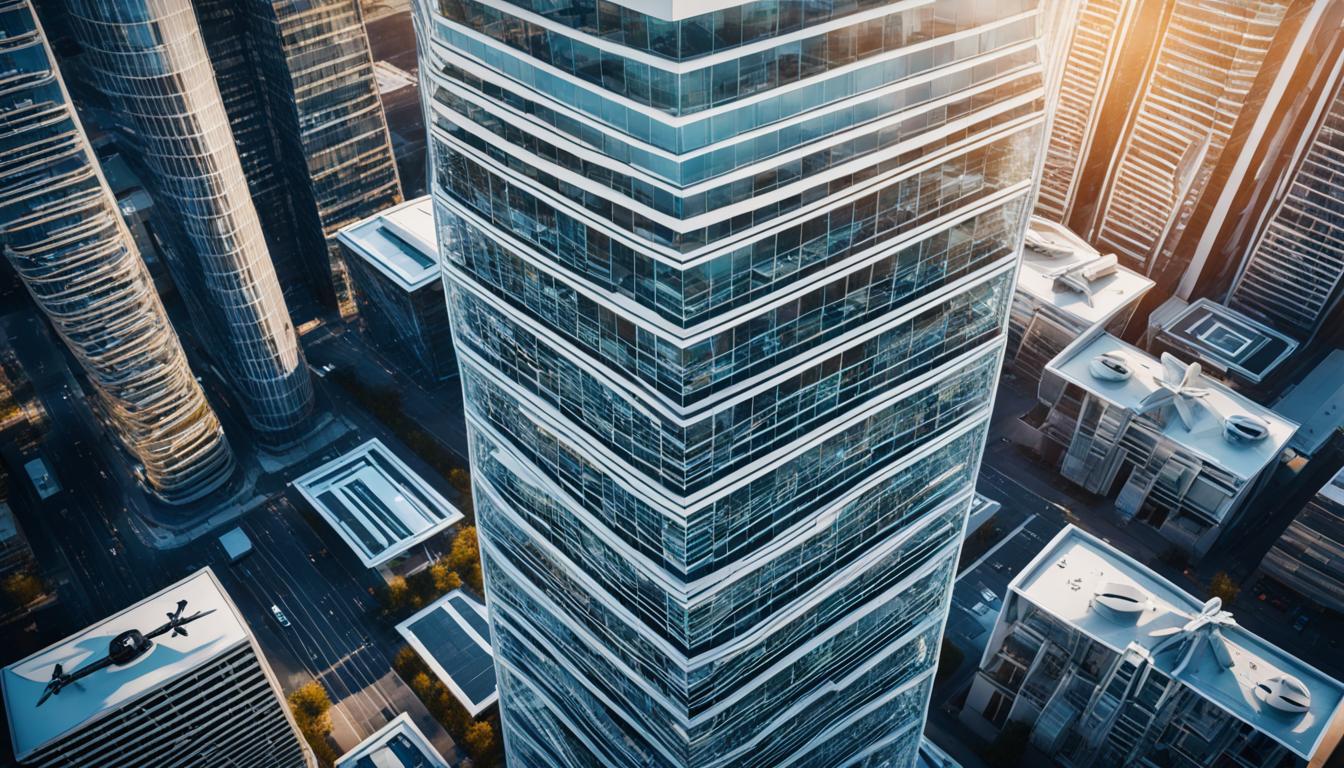Welcome to our guide on post-processing techniques for architectural images. In the world of architectural photography, capturing stunning visuals goes beyond just clicking the shutter. It involves refining and enhancing the images through advanced editing techniques tailored specifically for architecture. Whether you are a professional photographer or an enthusiast looking to elevate your architectural images, this article will provide you with valuable tips and insights to take your work to the next level.
Key Takeaways:
- Learn advanced editing techniques for architectural images.
- Discover professional tips and tricks for enhancing architectural photos.
- Explore architectural image editing software for efficient workflow.
- Understand best practices for editing architectural images.
- Unlock the full visual potential of your architectural photography.
Capturing Architectural Details with Lighting and Composition
When it comes to architectural photography, capturing the intricate details of a building requires a thoughtful approach to lighting and composition. In this section, we will explore essential tips and techniques that can elevate your architectural images and make them truly stand out.
Architectural Photography Lighting Tips
Lighting plays a crucial role in showcasing the architectural details and bringing them to life. Soft light, such as that found on overcast or cloudy days, can help emphasize the intricate textures and lines of a building. This type of lighting creates a diffused, even illumination that works beautifully for capturing architectural images (Image src=”https://seowriting.ai/32_6.png” alt=”architectural photography lighting tips”).
In architectural photography, soft light can bring out the beauty of the details by casting gentle shadows and highlighting the textures.
On the other hand, sidelight can create dramatic shadows and shapes, adding an abstract and artistic touch to your architectural images. The early morning or late afternoon sun provides a beautiful sidelighting effect that can accentuate the architectural features, creating depth and dimension.
Architectural Photography Composition Techniques
Composition is another vital aspect of capturing architectural details effectively. By paying attention to highlights and shadows, you can create compositions that emphasize the interplay of light and architecture. Look for interesting contrasts between light and dark areas to add depth and visual interest to your images.
Composing your architectural images to emphasize the highlights and shadows can create a visually engaging image that captures the viewer’s attention.
Additionally, shooting from higher vantage points offers a fresh perspective and unveils unseen patterns and details. Find elevated locations such as rooftops, balconies, or hills that allow you to capture a unique view of the building. This can bring a new and exciting dimension to your architectural photography.
Summary
By using lighting strategically and paying attention to composition, you can capture the architectural details in a way that truly showcases their beauty. Soft light and sidelight can help accentuate the textures and create visual interest, while shooting from higher vantage points offers a fresh perspective. Experiment with different lighting conditions and compositions to create stunning architectural images that capture the viewer’s imagination.
Exploring Architectural Details and Patterns
Architectural details and patterns are often overlooked in photography, but they can be a rich source of creative possibilities. By using a telephoto lens, we can zoom in and fill the frame with interesting patterns, offering a comprehensive view of architectural details. This allows us to capture the intricate elements that may go unnoticed by the naked eye.
When photographing architectural details, selecting the right aperture is crucial. A narrow aperture can produce sharp and focused images, ensuring that every detail is captured with clarity. On the other hand, a shallow depth of field can help us selectively focus on specific elements, creating a sense of depth and emphasizing the details.
Even seemingly unremarkable buildings can be transformed into compelling subjects by finding reflective surfaces nearby and utilizing different angles and points of focus. By exploring alternative perspectives, we can capture the unique textures, shapes, and lines that bring these structures to life.
One often overlooked aspect of architecture is the presence of light fixtures and other details. These elements offer vibrant colors, intriguing shapes, and captivating lines that add visual interest and enhance the overall composition of the image. By paying attention to these smaller details, we can create visually stunning photographs that capture the essence of the architecture.
Let’s dive deeper into the techniques and equipment that can help us in exploring architectural details and patterns.
Telephoto Lens for Architectural Details
A telephoto lens is a valuable tool for capturing architectural details. With its zoom capabilities, we can get up close and personal with intricate patterns, capturing every minute detail. The telephoto lens allows us to fill the frame with these patterns, creating visually striking images that highlight the beauty of architectural details.
Narrow Aperture for Architectural Details
Using a narrow aperture is essential for ensuring that every detail is sharp and in focus. By selecting a smaller aperture, we increase the depth of field, allowing us to capture intricate elements both in the foreground and the background. This technique is particularly useful when photographing wide architectural scenes or complex structures.
Shallow Depth of Field for Architectural Details
While a narrow aperture is beneficial for capturing sharp details, a shallow depth of field can create a sense of artistic depth and focus. By using a wider aperture, we can selectively blur the background and bring attention to specific elements, such as an intricate ornament or a unique architectural feature.
Capturing Details in Drab Buildings
Even in seemingly ordinary or drab buildings, there are hidden architectural gems waiting to be discovered. By exploring different angles, utilizing creative composition techniques, and accentuating specific details, we can transform these buildings into captivating subjects. Look for unique textures, patterns, and lines that can add visual interest and create a compelling narrative in your photographs.
Photographing Light Fixtures and Other Details
Light fixtures and other architectural details often go unnoticed, but they can be the key to adding vibrancy and visual interest to your images. Pay attention to the colors, shapes, and lines created by these details, and use them to enhance your composition. Experiment with different angles and perspectives to capture these elements in a way that highlights their unique characteristics.
Now that we have explored the importance of exploring architectural details and patterns, let’s move on to the next section where we will discuss the significance of tripods and elevated perspectives in architectural photography.
The Importance of Tripods and Elevated Perspectives
When it comes to architectural photography, tripods are an essential tool for capturing sharp and detailed images. They provide stability and eliminate camera shake, ensuring that every architectural detail is captured with precision. Whether you’re shooting exterior facades or intricate interior spaces, using tripods for architectural photography is crucial to achieving the best results.
One of the key advantages of using tripods is their ability to offer stability, especially when shooting with slower shutter speeds. This is particularly important when photographing architectural details that require longer exposures to capture intricate textures and fine lines. By eliminating camera shake, tripods help produce crisp and clear images that showcase the true beauty of the architecture.
Not only do tripods enhance the overall sharpness of your architectural images, but they also facilitate a deliberate and thoughtful approach to composition. With a sturdy tripod, you can take your time to experiment with different angles and perspectives, capturing the architectural elements in the most visually pleasing and impactful way. This allows you to create images that highlight the unique beauty and design of each structure.
Furthermore, elevated perspectives add a new dimension to architectural photography. By exploring these elevated viewpoints, such as shooting from staircases, balconies, or even employing drones, photographers can capture images that offer a fresh and unique interpretation of the architecture. These elevated perspectives provide a different vantage point, showcasing hidden architectural details and revealing the relationships between different levels of a structure.
It is important to note that safety and permissions must be taken into account when shooting from elevated positions. Ensure that you have the necessary permissions to access areas such as staircases and balconies, and always prioritize your safety and the safety of others. Additionally, when using drones, adhere to local regulations and guidelines to ensure a secure and responsible photography experience.
To summarize, tripods are indispensable tools for architectural photography, providing stability and allowing for the capture of sharp, high-quality images. Combined with elevated perspectives, photographers can showcase architectural details from unique vantage points, offering viewers a fresh and captivating visual experience.

Comparison of Tripod Types
| Tripod Type | Features | Pros | Cons |
|---|---|---|---|
| Traditional Tripod | Sturdy build, adjustable height, various leg angles | Excellent stability, versatile, suitable for all types of photography | Can be bulky and heavy, less portable |
| Travel Tripod | Lightweight, compact design, foldable legs | Highly portable, suitable for travel and outdoor photography | Less stability, may not support heavier camera equipment |
| Carbon Fiber Tripod | Lightweight material, excellent vibration damping | Enhanced stability, ideal for long exposures, reduces fatigue | Higher cost compared to other tripod types |
Tips for Successful Architectural Photography
Architectural photography presents numerous opportunities for capturing stunning images, but it also comes with its fair share of challenges. To ensure your architectural photographs are visually impactful and of the highest quality, it’s important to avoid common pitfalls and employ effective techniques.
Perspective distortion can detract from the accuracy and appeal of architectural images. To avoid this, pay attention to your camera position and lens choice, ensuring that vertical lines appear straight and parallel. Utilizing tilt-shift lenses or correcting perspective in post-processing can further enhance the accuracy and overall aesthetic of your architectural photographs.
Reflections, particularly in windows and glass doors, can also pose a challenge when photographing buildings. To handle reflections, consider adjusting your shooting angle or using a polarizing filter to minimize unwanted reflections. Additionally, being mindful of the time of day and the angles of light can help mitigate reflections and achieve the desired image quality.
When capturing architectural images, it’s important to not overlook statues and exterior details. These elements can add depth, visual interest, and a sense of scale to your photographs. Take the time to explore the surroundings and find unique angles that highlight these captivating architectural features.
Last but not least, post-processing is a crucial step in refining architectural photographs. It allows for perspective correction, color correction, exposure and contrast adjustments, noise reduction, sharpening, and HDR techniques. Taking the time to master post-processing tools and techniques will greatly enhance the overall quality and impact of your architectural images.
FAQ
What are post-processing techniques for architectural images?
Post-processing techniques involve editing and refining architectural images to enhance their visual appeal and bring out the beauty of architectural details. These techniques include perspective correction, color correction, exposure and contrast adjustments, noise reduction, sharpening, and HDR techniques.
How can lighting and composition enhance architectural images?
Lighting and composition are critical elements in capturing architectural details effectively. Soft light, such as overcast or cloudy weather, can emphasize architectural details. Sidelight during sunny mornings or afternoons can create dramatic shadows and shapes. By paying attention to highlights and shadows, photographers can create compelling compositions that focus on the interplay of light and architecture.
How can I capture architectural details and patterns in my images?
Use a telephoto lens to zoom in and fill the frame with interesting patterns and details. Select the right aperture, whether a narrow or shallow depth of field, to produce sharp and focused images that highlight intricate architectural details. Look for reflective surfaces and experiment with different angles and points of focus to transform seemingly unremarkable buildings into compelling subjects.
Are tripods important for architectural photography, and why?
Yes, tripods are invaluable tools for architectural photography. They provide stability and eliminate camera shake, especially when capturing architectural details that require slower shutter speeds. Tripods also facilitate a thoughtful and deliberate approach to composition, allowing photographers to take their time and experiment with different angles and perspectives.
What are some tips for successful architectural photography?
Avoiding perspective distortion and reflections, paying attention to often overlooked architectural elements such as statues and exterior details, and utilizing post-processing techniques are essential for successful architectural photography. Post-processing allows for perspective correction, color correction, exposure and contrast adjustments, noise reduction, sharpening, and HDR techniques to refine architectural images.
How Can Post-Processing Techniques Enhance Architectural Portfolio Images?
Post-processing techniques play a crucial role in crafting an architecture portfolio. By enhancing colors, adjusting lighting, and ensuring the overall clarity of the images, post-processing can elevate the visual appeal of architectural designs. This attention to detail can make a portfolio more impactful and memorable to potential clients.




